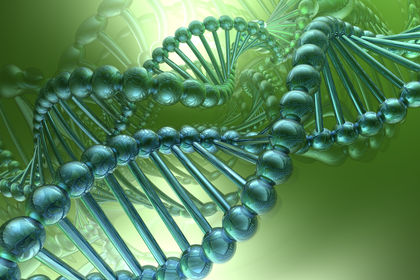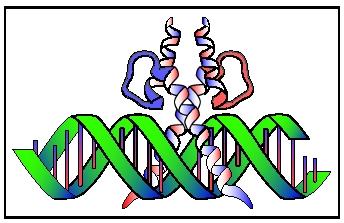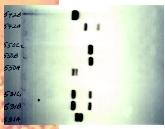DNA

DNA (deoxyribonucleic acid) is the molecule that stores genetic information in living systems. Like other organic molecules, DNA mostly consists of carbon, along with hydrogen, oxygen, nitrogen, and phosphorus. The fundamental structural unit of DNA is the nucleotide , which has two parts: an unvarying portion composed of sugar and phosphate, attached to one of four nitrogen-containing bases named adenine, cytosine, guanine, or thymine (abbreviated A, C, G, T).
The Double Helix
The structure of DNA, deduced in 1953 by James Watson, Francis Crick, and Rosalind Franklin, resembles that of a twisted ladder or spinal staircase composed of two long chains of nucleotides that are coiled around each other to form a double helix. The DNA ladder's two sidepieces (its double-stranded backbone) are made of alternating units of sugar and phosphate. The sugar is deoxyribose, which contains a ring of four carbons and one oxygen. A phosphate is an atom of phosphorus bonded to four oxygens. Bases attached to opposing sugars project inward toward each other to form rungs or steps, called base pairs . In contrast to the strong covalent (electron-sharing) bonds between nucleotides in a strand, the two bases in a base pair are held together only by much weaker hydrogen bonds . However, the cumulative attractive force of the hydrogen bonds in a chain of base pairs maintains DNA as a double-stranded molecule under physiological conditions. In the cell nucleus , DNA is bound to proteins to form chromosomes , and is coated with a layer of water molecules.
To make a sturdy rung, the two bases in a base pair have to interlock like pieces of a jigsaw puzzle, which only happens if their shapes and hydrogen-bonding characteristics are compatible. Only two combinations fulfill these requirements in DNA: G–C and A–T. This rule makes the two strands of a DNA molecule complementary , so that if the bases of one strand are ordered GGTACAT, the bases of the opposite strand must be ordered CCATGTA. The order of the bases on a strand (mirrored in the complementary strand) is called the sequence of the DNA, and embodies coded instructions for making new biomolecules: proteins, ribonucleic acid (RNA), and DNA itself.
Complementarity and Replication
Each strand of DNA has a direction in which it can be read by the cellular machinery, arising from the arrangement of phosphates and sugars in the

When DNA replicates, the weak hydrogen bonds of base pairs are broken and the two strands separate. Each strand acts as a template for the synthesis of a new complementary strand. Since the resulting new doublestranded molecule always contains one "old" (template) strand and one newly made strand, DNA replication is said to be semiconservative; it would be termed conservative if the two original template strands rejoined. By a similar mechanism (transcription), a DNA strand can be a template for the synthesis of RNA, which is a single-stranded nucleic acid that carries coded information from the DNA to the protein synthesizing machinery of the cell. During protein synthesis, the genetic code is used to translate the order of bases originally found in the DNA sequence into the order of amino acid building blocks in a protein.
Genes, Noncoding Sequences, and Methylation
DNA exists in nature as a macromolecule millions of base pairs long. In multicelled organisms, the complete set of genetic information—the genome —is divided among several DNA macromolecules (called chromosomes) in the cell nucleus. In contrast, the genomes of many one-celled organisms consist of a single, often circular, chromosome. The human genome contains 3.2 billion base pairs distributed among twenty-three chromosomes. Laid end to end, these would make a macromolecule 1.7 meters (5.5 feet) long; printed out, they would fill one thousand one-thousand-page telephone books. Furthermore, two copies of the genome are in almost every cell of humans and other diploid organisms. This vast amount of DNA packs into a cell nucleus, whose volume is only a few millionths of a cubic meter, by first spooling around globular proteins called histones . The DNA/histone complex then coils and curls up into even denser configurations, like a rubber band does when one holds one end and rolls the other end between one's fingers. Yet the human genome isn't nearly nature's biggest: the genome of a lily is just over ten times larger than a human's, although its nuclei are not significantly larger.
The information storage capacity of DNA is vast; a microgram (onemillionth of a gram) of DNA theoretically could store as much information as 1 million compact discs. The "useful" information contained in genomes consists of the coded instructions for making proteins and RNA. These information-containing regions of a genome are called genes. However, genes comprise less than 5 percent of the human genome. Most genomes consist largely of repetitive, noncoding DNA (sometimes called junk DNA) that is interspersed with genes and whose only apparent function is to replicate itself. Perhaps it helps to hold the chromosome together. The tenfold greater size of the lily genome compared to humans' is due to the presence of enormous amounts of repetitive DNA of unknown function.
While most cells of higher organisms contain all the genes in the genome, specialized cells such as neurons or muscle require expression from only some of the genes. One strategy for silencing unneeded genes is methylation . A methyl group (–CH 3 ) is added to cytosine nucleotides, but only if they are followed by a guanine in the sequence, that is, CG. Adding methyl groups to a region of DNA attracts repressive DNA-binding proteins to it and may also cause the region to compact even further, making it inaccessible to proteins that make RNA from DNA (the first step of protein synthesis). During DNA replication the pattern of methylation is preserved by specific proteins that add methyl groups to the new strand based on the location of CG methyl groups in the template strand. The most extreme case of repression by methylation is X-inactivation, in which one of the two X chromosomes in cells of a female mammal is entirely shut down, presumably because expression from one X provides enough protein in females, as it does in males (who have only one X chromosome).
SEE ALSO Chromosome, Eukaryotic ; Control of Gene Expression ; Crick, Francis ; Gene ; Mutation ; Nucleotides ; Replication ; RNA ; Watson, James
Steven A. Sullivan
Bibliography
Alberts, Bruce, et al. Molecular Biology of the Cell. New York: Garland Publishing, 2000.
Felsenfeld, Gary. "DNA." Scientific American 253 (1985): 58–67.
Levin, Benjamin. Genes VII. New York: Oxford University Press, 1999.
Watson, James D., and Francis H. Crick. "A Structure for Deoxyribose Nucleic Acid." Nature 171 (1953): 737.

A defect in the gene for a methylating enzyme causes Rett syndrome, a disorder responsible for mental retardation and movement disorders in young girls.
WILKINS, MAURICE (1916– )
New Zealand–born British biologist who helped James Watson and Francis Crick deduce the structure of deoxyribonucleic acid (DNA), for which the three men received a 1962 Nobel Prize. Wilkins secretly showed Watson an x-ray diffraction photo of DNA taken by researcher Rosalind Franklin. Watson and Crick later used Franklin's extensive unpublished data to build a model of DNA.
Comment about this article, ask questions, or add new information about this topic: